
Prosperous Bay Plain is an area on the eastern coast of Saint Helena, a British island territory in the South Atlantic Ocean. It is the site of the new Saint Helena Airport, and is notable for its high invertebrate biodiversity.

Prosperous Bay Plain is an area on the eastern coast of Saint Helena, a British island territory in the South Atlantic Ocean. It is the site of the new Saint Helena Airport, and is notable for its high invertebrate biodiversity.
Prosperous Bay Plain forms part of the eastern arid area of Saint Helena, and covers about 2.25 km2, comprising one of the largest areas of relatively level ground on the island. It was formed 8.5 million years ago by lava flows from Saint Helena's Southwest Volcano. The surface of the plain is covered by rocks, grit and dust, with what little soil there is containing high concentrations of mineral salts. [1]
Within the plain there is a 60 hectare (0.6 km2) depression known as the Central Basin, with a level dusty base. This forms a miniature mature desert ecosystem. [1]
It falls within the district of Longwood.
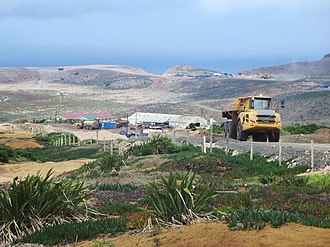
The climate of the plain is arid and plants are few, scattered and low-growing. Dusty areas and gullies are dominated by the native samphire Suaeda fruticosa . In rocky areas the more dominant plant is the introduced Hottentot fig ( Carpobrotus edulis ). On dry slopes, including those of the Central Basin, there are various chenopods, including the introduced saltbush Atriplex semibaccata . The plain holds a number of important populations of the island's endemic flora. The slopes of Dry Gut hosted the largest remaining group of barn fern ( Ceterach haughtonii ). Dry Gut was also home to the most abundant remaining population of the endemic boneseed, (Osteospermum sancta-helenae). Annual flushes of endemic babies'-toes (Hydrodea cryptantha), goosefoot (Chenopodium helenense) and neglected sedge (Bulbostylis neglecta) occur across the plain. There are a few scattered scrubwoods ( Commidendrum rugosum ), teaplants ( Frankenia portulacifolia ) and salad plant (Hypertelis acida), threatened endemics which may have grown more plentifully in the area in the past, before the introduction of exotic herbivores. [1] [2]
Much of the eastern end of Dry Gut has now been filled in to provide a base for the airport runway.
Before the discovery of Saint Helena in 1502, the plain was home to seabird breeding colonies. These disappeared after settlement of the island from predation by humans and feral cats. The only endemic land-bird still present is the critically endangered wirebird, of which the plain makes up 10% of its remaining habitat. [1]
Prosperous Bay Plain is a biodiversity hotspot, home to an extraordinary concentration of endemic invertebrates, the area being the main evolutionary centre on the island for animals adapted to arid habitats. Some 35–40 species and six genera recorded in this limited area occur nowhere else in the world. The Saint Helena giant earwig used to inhabit the plain, and may still, although there have been no live records of it since 1967. The Saint Helena giant beetle may also be extinct. [1] The mollusc Nesopupa turtoni in the whorl snail family Vertiginidae, previously known only as a fossil and long presumed to be extinct, was discovered alive in a 2003 survey [3]
Invertebrate habitats on the plain have been affected by many factors, including the systematic removal of loose and portable rocks for construction purposes, the formation of vehicle tracks, and the building of structures such as forts. The main threat to the invertebrate communities is the Saint Helena Airport, now completed, which, together with access roads, involved destruction of part of the plain, including part of the Central Basin. [4]

Saint Helena is an island in the South Atlantic Ocean, about midway between South America and Africa. St Helena has a land area of 122 square kilometres and is part of the territory of Saint Helena, Ascension and Tristan da Cunha which includes Ascension Island and the island group of Tristan da Cunha.
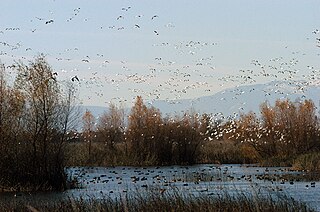
The California Central Valley grasslands is a temperate grasslands, savannas, and shrublands ecoregion in California's Central Valley. It a diverse ecoregion containing areas of desert grassland, prairie, savanna, riparian forest, marsh, several types of seasonal vernal pools, and large lakes such as now-dry Tulare Lake, Buena Vista Lake, and Kern Lake.

The Galápagos Islands xeric scrub, also known as the Galápagos Islands scrubland mosaic, is a terrestrial deserts and xeric shrublands ecoregion that covers the Galápagos Islands. The Galápagos Islands are volcanic in origin, and remote from continents and other islands. The ecoregion is well known for its unique endemic species, including giant tortoises, birds, and marine iguanas, which evolved in isolation to adapt to islands' environments.
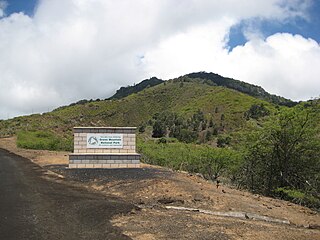
Green Mountain is a common name for "The Peak", the highest point on Ascension Island, which has gained some fame for claims that it is one of very few large-scale artificial forests.
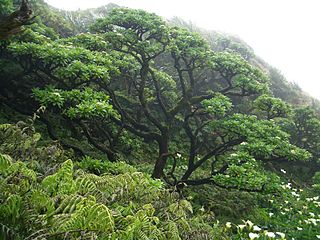
The Saint Helena scrub and woodlands ecoregion covers the volcanic island of Saint Helena in the South Atlantic Ocean. The island's remote location gave rise to many endemic species. First discovered and settled in the 1500s, the island has been degraded by human activities. Most of its native habitat has been destroyed, and many of its unique plants and animals are extinct or endangered.

The Saint Helena earwig or Saint Helena giant earwig is an extinct species of very large earwig endemic to the oceanic island of Saint Helena in the south Atlantic Ocean.
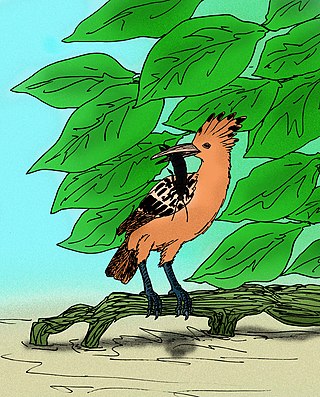
The Saint Helena hoopoe, also known as the Saint Helena giant hoopoe or giant hoopoe, is an extinct species of the hoopoe, known exclusively from an incomplete subfossil skeleton. It was last seen around 1550.

The flora of Saint Helena, an isolated island in the South Atlantic Ocean, is exceptional in its high level of endemism and the severe threats facing the survival of the flora. In phytogeography, it is in the phytochorion St. Helena and Ascension Region of the African Subkingdom, in the Paleotropical Kingdom.
Saint Helena, Ascension Island and Tristan da Cunha, as well the other uninhabited islands nearby, are a haven for wildlife in the middle of the Atlantic Ocean. The islands are or were home to much endemic flora and fauna, especially invertebrates, and many endemic fish species found in the reef ecosystems off the islands. The islands have been identified by BirdLife International as Important Bird Areas for both their endemic landbirds and breeding seabirds.

The Saint Helena plover, locally known as the wirebird due to its thin legs, is a small wader endemic to the island of Saint Helena in the mid-Atlantic. The bird is similar in appearance to Kittlitz's plover and the Madagascar plover, but a little larger and an absence of chamois coloring. It is the national bird of St Helena and has been depicted on the country's coins. Populations in general have been declining. Threats include predation by cats, the introduction of the common myna, deforestation, off-road vehicle use, the Saint Helena Airport and a projected windfarm. In 2016, the population had recovered to about 560 mature individuals, from a previous minimum of less than 200 in 2006; consequently, the species was downlisted to Vulnerable from its previous assessment of Critically Endangered.

Florida sand pine scrub is an endangered subtropical forest ecoregion found throughout Florida in the United States. It is found on coastal and inland sand ridges and is characterized by an evergreen xeromorphic plant community dominated by shrubs and dwarf oaks. Because the low-nutrient sandy soils do not retain moisture, the ecosystem is effectively an arid one. Wildfires infrequently occur in the Florida scrub. Most of the annual rainfall falls in summer. It is endangered by residential, commercial and agricultural development, with the largest remaining block in and around the Ocala National Forest. Lake Wales Ridge National Wildlife Refuge also holds a high proportion of remaining scrub habitat, while the Archbold Biological Station near Lake Placid contains about 20 km2 (7.7 sq mi) of scrub habitat and sponsors biological research on it.

The Saint Helena dove is an extinct species of flightless bird in the family Columbidae. It is monotypic within the genus Dysmoropelia. It was endemic to the island of Saint Helena in the South Atlantic Ocean. It is known from remains of Late Pleistocene age found at the Sugarloaf Hill locality, which consists of aeolian calcareous sands. The holotype consists of a right coracoid, with paratypes consisting of "distal end of right tarsometatarsus, (S/1963.25.29) distal half of right humerus, (S/1963.25.26) worn left tibiotarsus lacking distal end, distal portion of shaft of left tarsometatarsus, (S/1963.25.30) worn proximal end of right humerus. left ulna, proximal fragments of left ulnae, (175959) proximal end of right femur, (175962) distal end of right humerus"

Diana's Peak is the highest point, at 818 metres (2,684 ft), on the island of Saint Helena, a British overseas territory in the South Atlantic Ocean. It is of volcanic origin. The mountain and its surroundings with a total area of 81 ha were proclaimed a national park in March 1996, the first on the island. It is a preserve of several endangered endemic species, including tree fern, he cabbage and black cabbage trees, and whitewood. The park contains walking paths connecting the peaks - Mt. Actaeon (814m), Diana's Peak and Cuckold's Point (815m). The two shorter peaks are topped by large Norfolk pines. On the northern slopes there is a nursery for endemic species.

The Ascension scrub and grasslands ecoregion covers the dormant volcano, Ascension Island in the Atlantic Ocean. As well as shrubs and grasses wildlife on the island includes a range of unique flora and fauna. In particular the surrounding islets are important havens for many seabirds. However the seabird populations on Ascension Island itself have been severely affected by introduced species, especially cats, which were the subject of an eradication campaign between 2002 and 2006.

The Canterbury-Otago tussock grasslands is an ecoregion of the South Island, New Zealand, part of the wider tussock grasslands of New Zealand.

The North-east Saint Helena Important Bird Area is a 48 km2 tract of land covering about 39% of the island of Saint Helena, a British Overseas Territory in the South Atlantic Ocean. It has been identified by BirdLife International as an Important Bird Area (IBA) because it supports several colonies of breeding seabirds, including the red-billed tropicbird, as well as much of the remaining habitat of the endemic, and critically endangered, Saint Helena plover.
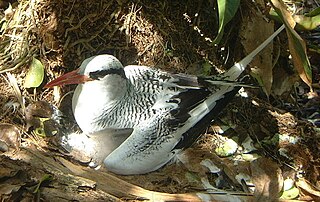
The South-west Saint Helena Important Bird Area is a 45 km2 tract of land covering about 37% of the island of Saint Helena, a British Overseas Territory in the South Atlantic Ocean. It has been identified by BirdLife International as an Important Bird Area (IBA) because it supports several colonies of breeding seabirds, including the red-billed tropicbird, as well as habitat of the endemic, and critically endangered, Saint Helena plover.
Nelson Philip Ashmole, commonly known as Philip Ashmole, is an English zoologist and conservationist. His main research field focused on the avifauna of islands, including Saint Helena, Ascension Island, Tenerife, the Azores, and Kiritimati. Other interests include insects and spiders, of which Ashmole discovered and described some new taxa.

The wildlife of Spain includes the diverse flora and fauna of Spain. The country located at the south of France has two long coastlines, one on the north on the Cantabrian Sea, another on the East and South East on the Mediterranean Sea, and a smaller one on the west and south west on the Atlantic Ocean, its territory includes a big part of the Iberian Peninsula, the Canary Islands, the Balearic Islands and two enclaves in North Africa, Ceuta and Melilla. The country has many endemic species, especially those restricted to the island groups, and mainly because of the rich geography and the different climate zones, Spain is one of the countries in Europe with the greatest biodiversity.
Asplenium haughtonii, also known as the Barn fern, is a species of fern in the family Aspleniaceae. It is native to Saint Helena.